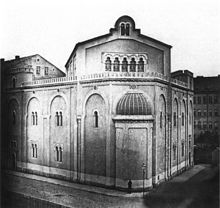
Gottfried Semper was a German architect, art critic, and professor of architecture who designed and built the Semper Opera House in Dresden between 1838 and 1841. In 1849 he took part in the May Uprising in Dresden and was put on the government's wanted list. He fled first to Zürich and later to London. He returned to Germany after the 1862 amnesty granted to the revolutionaries.
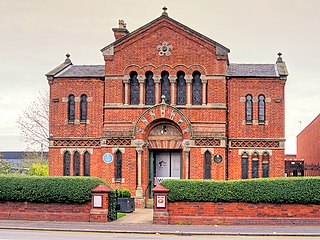
Manchester Jewish Museum occupies the former Spanish and Portuguese synagogue and an adjacent building on Cheetham Hill Road in Manchester, England. It is a grade II* listed building.

The Leipzig Trade Fair is a major trade fair, which traces its roots back for nearly a millennium. After the Second World War, Leipzig fell within the territory of East Germany, whereupon the Leipzig Trade Fair became one of the most important trade fairs of Comecon and was traditionally a meeting place for businessmen and politicians from both sides of the Iron Curtain. Since 1996, the fair has taken place on the Leipzig fairgrounds, located about 7 kilometres (4.3 mi) north of the city centre.

Synagogue architecture often follows styles in vogue at the place and time of construction. There is no set blueprint for synagogues and the architectural shapes and interior designs of synagogues vary greatly. According to tradition, the Shekhinah or divine presence can be found wherever there is a minyan, a quorum, of ten. A synagogue always contains an Torah ark where the Torah scrolls are kept, called the aron qodesh by Ashkenazi Jews and the hekhal by Sephardic Jews.

The Leopoldstädter Tempel was the largest synagogue of Vienna, in the district (Bezirk) of Leopoldstadt. It was also known as the Israelitische Bethaus in der Wiener Vorstadt Leopoldstadt. It was built in 1858 in a Moorish Revival style by the architect Ludwig Förster. The tripartite facade of the Leopoldstädter, with its tall central section flanked by lower wings on each side, became the model for numerous Moorish Revival synagogues, including the Choral Temple in Bucharest, which has an almost identical main facade, the Zagreb Synagogue, the Spanish Synagogue in Prague, the Tempel Synagogue in Kraków and the Grand Synagogue of Edirne.

The Sofia Synagogue is the largest synagogue in Southeastern Europe, one of two functioning in Bulgaria and the third-largest in Europe.

Moorish Revival or Neo-Moorish is one of the exotic revival architectural styles that were adopted by architects of Europe and the Americas in the wake of Romanticist Orientalism. It reached the height of its popularity after the mid-19th century, part of a widening vocabulary of articulated decorative ornament drawn from historical sources beyond familiar classical and Gothic modes. Neo-Moorish architecture drew on elements from classic Moorish architecture and, as a result, from the wider Islamic architecture.

The Dohány Street Synagogue, also known as the Great Synagogue or Tabakgasse Synagogue, is a historical building on Dohány Street in Erzsébetváros, the 7th district of Budapest, Hungary. It is the largest synagogue in Europe, seating 3,000 people and is a centre of Neolog Judaism.
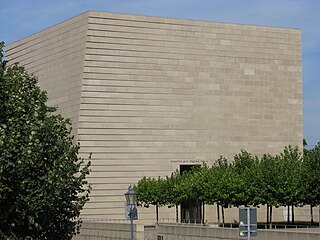
The New Synagogue is a synagogue in the old town of Dresden, Germany. The edifice was completed in 2001 and designed by architects Rena Wandel-Hoefer and Wolfgang Lorch. It was built on the same location as the Semper Synagogue (1839–1840) designed by Gottfried Semper, which was destroyed in 1938, during the Kristallnacht.
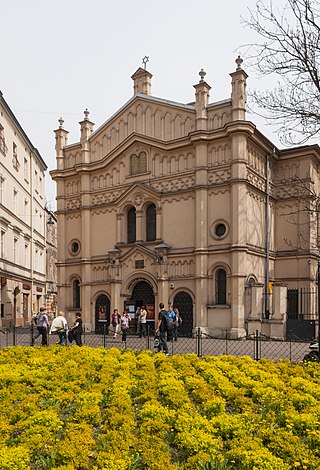
The Tempel Synagogue is a synagogue in Kraków, Poland, in the Kazimierz district.

The Central Synagogue is a Reform Jewish congregation and synagogue at 652 Lexington Avenue, at the corner of East 55th Street in the Midtown Manhattan neighborhood of New York City. Built from 1870 to 1872 and designed by Henry Fernbach in the Moorish Revival style, the synagogue was influenced by Budapest's Dohány Street Synagogue. It has been continuously used by a congregation for longer than any other in New York state, except Congregation Berith Sholom in Troy, and is among the oldest existing synagogue buildings in the United States.

The Grand Choral Synagogue of Saint Petersburg is the third-largest synagogue in Europe. Other names include The Great Choral Synagogue of Saint Petersburg and The Edmond J Safra Grand Choral Synagogue. Sometimes it is simply referred to as the Saint Petersburg Synagogue or Bolshaya Sinagoga. It was built between 1880 and 1888, and consecrated in December 1893. The synagogue is located at 2 Lermontovskii Prospekt, Saint Petersburg, Russia. The Chief Rabbi of Saint Petersburg is Menachem Mendel Pewzner. Today the synagogue is a registered landmark and an architectural monument of federal importance.
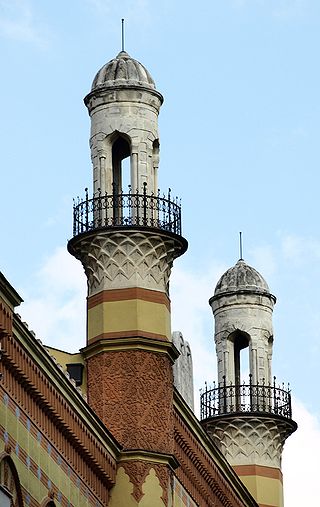
The Rumbach Street synagogue is located in Belváros, the inner city of the historical old town of Pest, in the eastern section of Budapest. The synagogue in Rumbach Street was built in 1872 to the design of the Viennese architect Otto Wagner. Intentionally meant to serve the members of the Neológ community of Pest, its construction coincided with the Schism in Hungarian Jewry of 1869, and it became the home of the more conservative Status Quo faction.
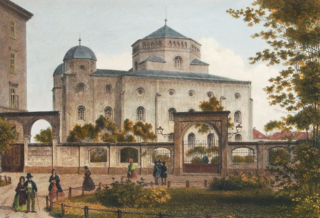
The Semper Synagogue, also known as the Dresden Synagogue, designed by Gottfried Semper and built from 1838 to 1840, was dedicated on 8 May 1840. It was an early example of the Moorish Revival style of synagogue architecture.
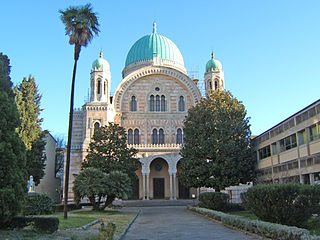
The Great Synagogue of Florence is one of the largest synagogues in South-central Europe, situated in Florence, in Italy. The synagogue of Florence was one of the most important synagogues built in Europe in the age of the Jewish emancipation, reached by the Jewish communities living in the Grand Duchy of Tuscany in 1848.

The Stara Synagogue, also known as Alte Szil and ‘’’Alt Stodt Shul’’’ meaning Old Town Synagogue was a "beautiful" synagogue in Łódź, Poland. The name Stara means old, many Polish cities called the oldest synagogue in town the Stara synagogue. The Stara was Łódź's principal Orthodox synagogue. It was built by Orthodox industrial magnates who wished to outshine, or at least compete with, the 1881 Great Synagogue (Łódź) built by the Reformed Jewish community.

The New Synagogue in Ostrów Wielkopolski, Poland, is located in the city's center on 21 Raszkowska Street, which was the northern edge of the former Jewish district. Currently, this is the only preserved metropolitan synagogue. It is built in the once very popular Moorish Revival style. It is the most precious monument of religious architecture in Ostrów Wielkopolski. Long neglected, the synagogue has been fully restored in 2010. See the municipal website for updates:
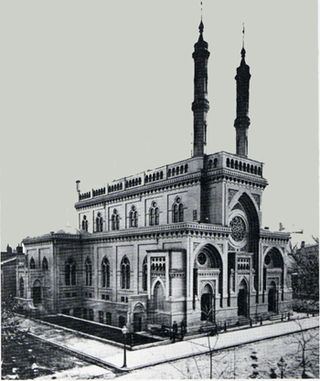
James Keys Wilson was a prominent architect in Cincinnati, Ohio. He studied with Charles A. Mountain in Philadelphia and then Martin E. Thompson and James Renwick in New York, interning at Renwick's firm. Wilson worked with William Walter at the Walter and Wilson firm, before establishing his own practice in Cincinnati. He became the most noted architect in the city. His Old Main Building for Bethany College and Plum Street Temple buildings are National Historic Landmarks. His work includes many Gothic Revival architecture buildings, while the synagogue is considered Moorish Revival and Byzantine Architecture.
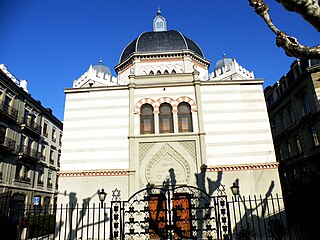
The Beth Yaakov Synagogue is located in the heart of the city of Geneva. It has also been known as the Grande Synagogue. It was built between 1858 and 1859 for the Ashkenazi Jewish community, which comprised about 200 people at the time of the synagogue's construction.

Gottschedstrasse is a residential street in Leipzig, Germany, in the so-called theater district of the Innere Westvorstadt. It extends over a length of around 650 m (2,132.5 ft) in an east–west direction from the Inner City Ring Road at the level of St. Thomas Church to the Poniatowski monument at Elstermühlgraben. It is named after the writer, literary and theater theorist Johann Christoph Gottsched (1700–1766). It is primarily known as a pub and nightlife area.
